Université Laval
| Université Laval | |
 | |
| Motto | Deo favente haud pluribus impar |
|---|---|
Motto in English | By the grace of God, to no one equal |
| Type | Public |
| Established |
1663 (Séminaire de Québec) December 8, 1852 (Royal Charter) |
| Endowment | $120.5 million |
| Rector | Denis Brière |
| Undergraduates | 28,902 |
| Postgraduates | 8,689 |
| Location | Quebec City, Quebec, Canada |
| Campus | Urban/Suburban |
| Colours | Red and Gold |
| Athletics | CIS – RSEQ |
| Nickname | Rouge-et-Or |
| Affiliations | AUCC, CARL, IAU, AUFC, UArctic, ACU, CIS, QSSF, CBIE, U15 |
| Website | www.ulaval.ca |
 | |
Université Laval is a French-language, public research university in Quebec City, Quebec, Canada. The University was founded by royal charter issued by Queen Victoria in 1852, with roots in the founding of the Séminaire de Québec in 1663 by François de Montmorency-Laval, making it the oldest centre of higher education in Canada and the first North American institution to offer higher education in French. The university, whose main campus was erected from the 1950's onward in the suburban borough Sainte-Foy–Sillery–Cap-Rouge, is ranked among the top ten Canadian universities in terms of research funding.[1]
History


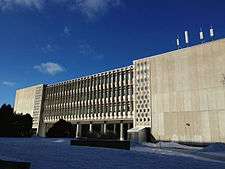
The university began as the Séminaire de Québec, which was founded in 1663 by François de Montmorency-Laval, a member of the House of Laval and the first Bishop of New France.[2]
During the French Regime the institution mainly trained priests to serve in New France. After the Conquest of 1760, the British expanded education in Canada to include the liberal arts. French Canadians had at the time no opportunity to pursue higher education, and Bishop Bourget of Montreal suggested expanding the Séminaire de Québec into Université Laval. Louis Casault, a priest who taught physics at the Séminaire de Québec, went to Europe to seek a royal charter and study the best university systems there.
The Séminaire de Québec was granted a royal charter on December 8, 1852, by Queen Victoria, at the request of Lord Elgin (Governor-General of the Province of Canada), creating Université Laval with "the rights and privileges of a university".[3] The charter was signed in 1852. Pope Benedict XV approved the plan and authorized the institution to establish chairs of theology and confer degrees.[4]
In 1878, the university opened a second campus in Montreal, which became the Université de Montréal on May 8, 1919, by a writ of Pope Benedict XV. In 1971, a second charter transferred all authority to the Université Laval council.[3]
By 1925, the university had outgrown its location. The Old City was very crowded, making it difficult to add new buildings to the campus. The university moved to Sainte-Foy which at the time was a semi-rural community west of the Quebec city centre in the 1950s. The School of Architecture returned to the old building (now affectionately referred to as Le Vieux Séminaire) in 1989.
Université Laval is governed by a board of governors and a faculty senate. This structure was modelled on the provincial University of Toronto Act of 1906, which established a bicameral system of university government consisting of a senate (faculty), responsible for academic policy, and a board of governors (citizens) exercising exclusive control over financial policy and having formal authority in all other matters. The president, appointed by the board, was to serve as a link between the two bodies and lead the institution.[5]:306
In the early part of the 20th century, the need for higher education expanded beyond the classical fields of theology, law and medicine, and the university introduced science and social-science departments such as forestry and household science.[5]:1904 In addition, graduate training based on the German-inspired American model of specialized course work and the completion of a research thesis was introduced.[3]
The university opened its department of social, political, and economic sciences in 1938, signalling a change of approach that continued into the 1960s, based on an idea of higher education as the key to social justice and economic productivity for individuals and society.[6]
The royal charter that founded Université Laval in 1852 was designated a National Historic Event in 1972.[7]
"Laval", a waltz by French-Canadian ragtime composer, Wilfrid Beaudry, was dedicated to the students at Laval University and the University of Montreal. The music for piano was published in Québec by J. Beaudry, circa 1906.[8]
Buildings and features
The Laval University building on St. Denis Street was designed by Maurice Perrault in 1893–94.[9] Joseph Simeon Bergeron (architect) designed several buildings at Laval University including the School of Chemistry (1923), the addition on Ste. Famille Street (1931), the Mining School (1938), and the cafeteria building (1945).[10]
Université Laval's main campus covers 1.2 km2 (0.46 sq mi) and has over 30 buildings, all linked by 10 km (6.2 mi) of underground walkways, which are particularly useful in the winter. Of the campus lands, 56 percent are wooded areas, grasslands, and sports fields. The campus is home to the Roger-Van den Hende botanical garden which contains some 67 species of deciduous and coniferous trees and 60 different species of birds.
Laval University also hosts a branch of the National Archives of Quebec.
Programs
As of 2002, Université Laval offered over 350 programs to more than 38,000 students. The university also attracts more than 2,500 foreign students annually, and has almost 1,000 students drawn from Canadian provinces outside of Quebec. Many students come to the university for the Français pour non-francophones program that offers instruction in French as a second language to students from Canada and around the world. It is also the only university in Quebec which trains forestry engineers. Since the mid-1980s, Université Laval has offered distance learning; over 30 programs and 400 courses are offered by distance learning, of which 80% are accessible from the internet.
Faculties and schools
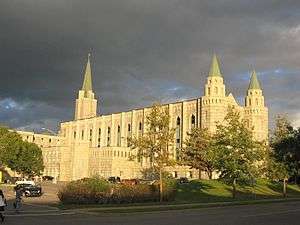
- Administrative Sciences
- Agriculture and Food sciences*
- Architecture, Urban planning and Visual arts
- Dentistry
- Education
- Faculté de Droit (Faculty of Law)
- Faculté des Lettres (Humanities)
- Forestry, Geography and Geomatics**
- Institut Québécois des Hautes Études Internationales (HEI)
- Arts
- Medicine
- Music
- Nursing
- Pharmacy
- Philosophy
- Postgraduate Studies
- Science and Engineering
- Agroenvironnemental Engineering, Agricultural Engineering, Chemical Engineering, Civil Engineering, Electrical Engineering, Mechanical Engineering, Geology and Geological Engineering, Computer Engineering, Metallurgical Engineering, Mining Engineering, Physics, Chemistry, Rural Engineering[11]
- Social Sciences
- Theology and Religious Studies
* The Département des Sciences des Aliments et de Nutrition has an accredited dietetic program. The university is accredited by a professional organization such as the Dietitians of Canada and the university's graduates may subsequently become registered dietitians.
** The Faculty is part of the AUFSC and has accredited baccalaureate of science programs with specializations in forestry & environmental management; forestry operations (co-op) and forestry engineering.
| University rankings | |
|---|---|
| Global rankings | |
| ARWU World[12] | 201–300 |
| QS World[13] | 372 |
| Times World[14] | 251-300 |
| US News and World Report Global[15] | 257 |
| Canadian rankings | |
| QS National[16] | 15 |
| Times National[14] | 12-14 |
| US News and World Report National[15] | 11 |
| Maclean's Medical/Doctoral[17] | 13 |
| Maclean's Reputation[18] | 14 |
University press
Les Presses de l'Université Laval, which was founded in 1950, deals with Canadian civilization, literature, medieval studies, law, social sciences, physical sciences and engineering.[19]
University cooperative
The Coopérative de l'Université Laval is engaged in the sale of products to customers throughout the university, such as books, lecture notes and computers.
Athletics and sports teams
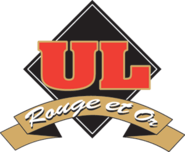
Athletics take place at the PEPS complex. Laval's varsity sports teams are named the Rouge-et-Or (Red & Gold). The men's football team was the 2013 Canadian champion and won seven Vanier Cups in ten years from 2003 to 2013.
Notable alumni
Numerous public figures, including Prime Ministers of Canada, Premiers of Quebec, Supreme Court Justices, federal Cabinet Ministers, Senators, and Lieutenant-Governors as well as national and international athletes have graduated from l'Université Laval. Some of the more prominent today are:
- Prime Ministers of Canada Louis St. Laurent, Brian Mulroney and Jean Chrétien
- Premiers of Quebec Lucien Bouchard, Pierre-Joseph-Olivier Chauveau, Edmund James Flynn, Jean Lesage, René Lévesque, Pauline Marois, Simon-Napoléon Parent and Louis-Alexandre Taschereau
- Supreme Court Justices Louis LeBel, Claire L'Heureux-Dubé, Charles Fitzpatrick, Arthur Cyrille Albert Malouin, Lawrence Arthur Dumoulin Cannon, Louis-Philippe Pigeon, Julien Chouinard, Robert Taschereau, Henri-Elzéar Taschereau, Thibaudeau Rinfret
- Archduke Carl Ludwig of Austria (1918–2007)
- Archduchess Charlotte of Austria, social worker and royal heiress
- Archduke Rudolf of Austria (1919–2010)
- Mahamat Ali Adoum, permanent representative of Chad to the United Nations; former Minister of foreign affairs (1992–93)
- Jacques-Édouard Alexis, prime minister of Haiti from 1999–2001 and 2006–2008
- Marcel Aubut, president of the Canadian Olympic Committee
- Boris Bede, gridiron football player
- Louis-Nazaire Bégin, a Canadian Cardinal of the Roman Catholic Church
- Édith Butler, Acadian singer
- Conrad Black, former media magnate
- Gérard Bouchard, Academic and public intellectual
- Charles Sandwith Campbell, benefactor of Montreal; Governor of McGill University
- Lawrence Cannon, Canadian Minister of Foreign Affairs from 2008 to 2011
- Carme Chacón, Spanish Minister of Defence from 2008 to 2011
- Thomas Chapais, lawyer and federal politician
- Thomas Chapais, lawyer and federal politician
- Marcel Crête, jurist and Chief Justice of Quebec
- Raymond Chrétien, Former diplomat and lawyer
- Raoul Dandurand, lawyer, federal politician, diplomat, president of the League of Nations Assembly for 1925
- Charles De Koninck, philosopher and theologian
- Stéphane Dion, Minister of Foreign Affairs, former minister of the environment and former leader of the Liberal Party of Canada
- Gilbert Finn, 26th Lieutenant Governor of New Brunswick
- Eugène Fiset, former Surgeon General of Canada, 18th Lieutenant Governor of Quebec
- Michael Fortier, senator
- Wilfrid Gariépy, Alberta cabinet minister
- Louis Garneau, Olympic cyclist and businessman
- Paule Gauthier, Lawyer, arbitrator, corporate director, former chair of the Security Intelligence Review Committee 1996–2004
- Léon Gérin, lawyer and president of the Royal Society of Canada
- Daniel Joseph Greene, Premier of Newfoundland, 1894-95
- Gustave Guillaume, linguist, philologist and Volney Prize laureate
- Luc Langlois, philosopher, Ordre des Palmes Académiques laureate, Dean of the Faculty of Philosophy, 2002-2010
- Habiba Zehi Ben Romdhane, Tunisian Minister of health
- Pierre Harvey, Olympic cyclist and cross-country skier
- Louis de Lotbiniere-Harwood, Dean of Medicine at Université de Montréal; President of the Hôpital Notre-Dame
- Samuel William Jacobs, lawyer, Member of Parliament and a leader of the Canadian Jewish community
- Jean, Grand Duke of Luxembourg
- Larkin Kerwin, physicist, first president of the Canadian Space Agency, 1989–1992
- Fernand Labrie, physician and medical researcher
- Gérald Lacroix, ISPX, cardinal, archbishop of the Roman Catholic Archdiocese of Quebec and Primate of Canada
- Marc Laliberté, CEO, Via Rail Canada
- Pierre Lavertu, CFL player
- Jean Leclerc, chairman, Leclerc biscuits and former provincial politician
- Marc Lortie, diplomat
- Pearlette Louisy, Governess-General of Saint Lucia
- Frederick Edmund Meredith, lawyer and businessman, 8th chancellor of Bishop's University
- Ed Millaire, professional hockey player Montreal Canadiens
- Gaston Miron, poet and author
- Michael Meighen, senator
- Ben Mulroney, television host and son of former prime minister Brian Mulroney
- Marc Ouellet, cardinal, prefect of the Congregation for Bishops and president of the Pontifical Commission for Latin America
- Aimé Pelletier, surgeon and like Bertrand Vac, influential Quebec novelist, particularly in the 1950s.
- Laurent Picard, academic, former president of the Canadian Broadcasting Corporation
- Louis J. Robichaud, 24th premier of New Brunswick
- Adolphe-Basile Routhier, judge and writer
- David Saint-Jacques, astrophysicist and astronaut for the Canadian Space Agency
- David Servan-Schreiber, physician and author
- Raymond C. Setlakwe, senator
- Charles Sirois, businessman and venture capitalist
- Réjean Thomas, physician, Médecins Sans Frontières
- Arthur Tremblay, senator
- Rodrigue Tremblay, economist
- Gérard Veilleux, former senior civil servant, president of the Canadian Broadcasting Corporation (1989–1993)
- Gilles Vigneault, artist
- Niklaus Wirth, computer scientist, Turing Award winner
- Jean-Charles Gille, engineer, psychiatrist and professor of medicine.
Rhodes Scholars
- Marius Barbeau 1910
- Edgar Rochette 1914
- Roger Gaudry 1937
- Julien Chouinard 1951
- Thomas De Koninck 1956
- Gregory Kates 1966
- Jean-François Garneau 1982
Gallery
 Ferninand Vandry Pavillion, hosting health sciences faculties
Ferninand Vandry Pavillion, hosting health sciences faculties L'Homme devant la Science (1963), mural by Jordi Bonet
L'Homme devant la Science (1963), mural by Jordi Bonet Water Garden at Roger Van den Hende botanical garden
Water Garden at Roger Van den Hende botanical garden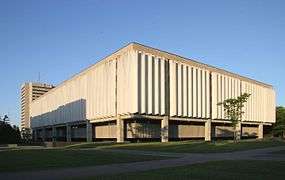 Social science library building
Social science library building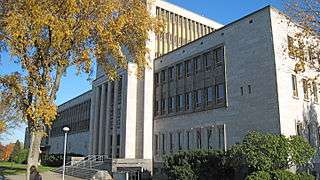 Palasis-Prince building (administrative sciences)
Palasis-Prince building (administrative sciences)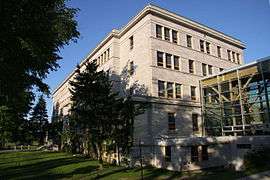 Abitibi-Price building (forestry, geography and geomatics)
Abitibi-Price building (forestry, geography and geomatics)- Gene-H.-Kruger building
See also
- List of rectors of Université Laval
- List of universities in Quebec
- List of universities in Canada
- Group of Thirteen (Canadian universities)
- List of oldest universities by region
- Quebec City
- Canadian university scientific research organizations
- Higher education in Quebec
- CHYZ campus radio station
References
- ↑ Université Laval. "Université Laval at a Glance". (accessed 17 April 2007)
- ↑ "The Project Gutenberg eBook of The Makers of Canada: Index and Dictionary of Canadian History, Edited by Lawrence Johnstone Burpee and Arthur G. Doughty.". Retrieved 28 August 2015.
- 1 2 3 Laval University/Université Laval
- ↑ The Project Gutenberg EBook #6466 of 'The Intellectual Development of the Canadian People, A historical review' by John George Bourinot, House of Commons, Ottawa, February 17th, 1881
- 1 2 Langton, Hugh Hornby; Macallum, Archibald Byron (1906). The University of Toronto and its colleges, 1827-1906. The University Library, pub. by the librarian.
- ↑ Behiels, Michael, "Le père Georges-Henri Lévesque et l'établissement des sciences sociales à Laval: 1938–1955", Revue de l'Université d'Ottawa 52, no. 3 (juil.-sept. 1982). Appears in English translation in "Youth, University, and Canadian Society", edited by Paul Axelrod and John G. Reid. Kingston and Montreal: McGill-Queen's University of Press, 1989.
- ↑ National Historic Event
- ↑ Wilfrid Beaudry (1906). "Laval". Amicus.collectionscanada.gc.ca. Retrieved July 1, 2016.
- ↑ "Perrault, Maurice". Retrieved 28 August 2015.
- ↑ "Bergeron, Joseph Simeon". Retrieved 28 August 2015.
- ↑ Canadian Engineering Memorial Foundation – University List
- ↑ "Academic Ranking of World Universities 2016 - Canada". ShanghaiRanking Consultancy. 2016. Retrieved 7 October 2016.
- ↑ "QS World University Rankings - 2016". QS Quacquarelli Symonds Limited. 2016. Retrieved 5 September 2016.
- 1 2 "World University Rankings 2016-2017". Times Higher Education. 2016. Retrieved 7 October 2016.
- 1 2 "Best Global Universities in Canada". www.usnews.com. U.S. News & World Report. 29 October 2015. Retrieved 7 October 2016.
- ↑ "QS World University Rankings® 2016-2017". QS Quacquarelli Symonds Limited. 2016. Retrieved 7 October 2016.
- ↑ "University Rankings 2016: Medical Doctoral". Maclean's. 5 November 2015. Retrieved 7 October 2016.
- ↑ "Top 20 Universities by Reputation". Maclean's. 5 November 2015. Retrieved 7 October 2016.
- ↑ University Presses
External links
| Wikimedia Commons has media related to Université Laval. |
- Official website
- Bibliothèque de l'Université Laval
- Université Laval Foundation
- Faculty of Forestry, Georgraphy and Geomatics
-
 Herbermann, Charles, ed. (1913). "Laval University of Quebec". Catholic Encyclopedia. New York: Robert Appleton Company.
Herbermann, Charles, ed. (1913). "Laval University of Quebec". Catholic Encyclopedia. New York: Robert Appleton Company.
Coordinates: 46°46′48″N 71°16′29″W / 46.78000°N 71.27472°W
